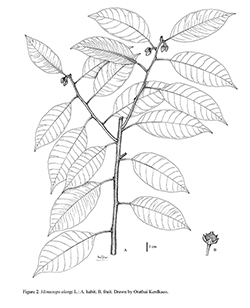e-Flora of Thailand
Volume 11 > Part 4 > Year 2014 > Page 630 > Sapotaceae > Mimusops
Mimusops elengi L.wfo-0000244577
Sp. Pl.: 349. 1753; Kurz, Forest Fl. Burma 2: 123. 1877; C.B.Clarke in Hook.f., Fl. Brit. India 3: 548. 1882; Brandis, Indian Trees: 425. 1906; Ridl., Fl. Malay Penins. 2: 278. 1923; Lecomte, Fl. Indo-Chine 3: 879, f. 95. 1930; H.J.Lam, Bull. Jard. Bot. Buitenzorg Sér. 3, 7: 234. 1925; H.R.Fletcher in Craib & Kerr, Fl. Siam. 2: 362. 1938; P.Royen, Blumea 6: 594. 1952; Aubrév., Fl. Cambodge, Laos & Vietnam, Sapotacées: 16, 1963; Pennington, Gen. Sapot.: 123. 1991; Verdcourt & Meijer in Dassan., Fosberg & Clayton, Fl. Ceylon 9: 356. 1995; Long & Rae in Grierson & Long, Fl. Bhutan 2(2): 573. 1999; Chantar., Thai Forest Bull., Bot. 27: 150. 1999; Julaihi in Soepadmo, Saw & Chung, Tree Fl. Sabah & Sarawak 4: 269, f. 16. 2002. Fig. 2; Plate CXXIV: 7.
Accepted Name : This is currently accepted.
Synonyms & Citations :
Description : Tree to 10 m tall; branchlets terete, reddish brown puberulous. Leaves elliptic, broadly elliptic, oblong-elliptic or ovate, 7–14.5 by (3.2–) 4–7 cm; apex acute or acuminate; base broadly acute or oblique; upper surface glabrous; lower surface sparsely reddish brown tomentose or glabrescent; midrib raised, crested above; secondary veins 9–15 on each side; tertiary veins inconspicuous above, more prominent below; petioles 1–2 cm long, narrowly grooved above, sparsely reddish brown tomentose or glabrescent; stipules minute. Flowers solitary or fasiculate, axillary; pedicles 0.7–1.8 mm long, reddish brown puberulous. Sepals triangular, free, somewhat fused, 0.6–0.9 mm long; outer sepals 6.8–8.2 by 2.5–3.7 mm, reddish brown sericeous except for a glabrous basal part inside; inner sepals yellowish brown sericeous with a furrow line outside, glabrous and crested inside. Corolla glabrous except for a few hairs on the lower surface outside; tube 1–1.7 mm long; segments 5.3–6.2 by 0.8–1.3 mm; median segment elliptic or lanceolate, with obtuse apex; lateral segments slender, lanceolate, with acute apex. Stamens 4.3–5 mm long; filaments free, short, 1–1.3 mm long, pubescent; anthers linear or sagittate, 3–3.8 mm long, glabrous; connective 0.2–0.6 mm long; staminodes lanceolate or triangular, 3.7–5 by 0.8–1.2 mm, lower surface pubescent outside, glabrous inside, inflexed to the gynoecium. Ovary reddish brown hirsute; style 4.5–5.6 mm long. Fruit elliptic, ca 2.2 by 1.5 cm.
Thailand : All provinces, a very common cultivated tree in temple grounds, wild in the south and west.
Distribution : India (type), Sri Lanka, SE Asia.
Ecology : In evergreen forests, 0–350 m alt or cultivated as a shade or an ornamental tree.
Vernacular : Kun (กุน)(Peninsular); kaeo (แก้ว)(Northern); sang dong (ซางดง)(Lampang); phikun (พิกุล)(Central); phikun khao (พิกุลเขา); phikun thuean (พิกุลเถื่อน)(Nakhon Si Thammarat); phikun pa (พิกุลป่า)(Satun).
Uses: Ornamental. All parts of tree used in native medicine. Ripe fruits edible but astringent.


